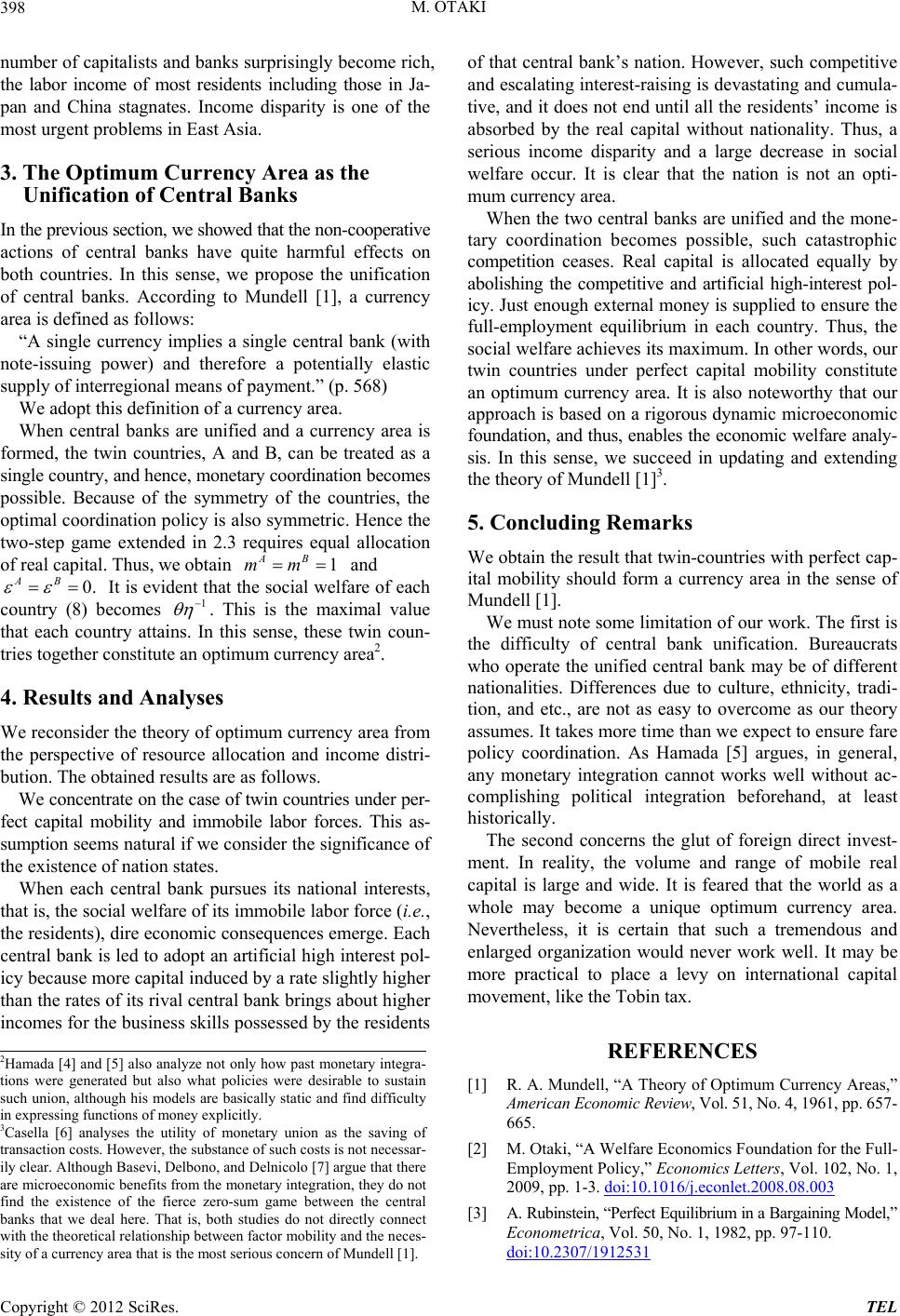
M. OTAKI
398
number of capitalists and banks surprisingly become rich,
the labor income of most residents including those in Ja-
pan and China stagnates. Income disparity is one of the
most urgent problems in East Asia.
3. The Optimum Currency Area as the
Unification of Central Banks
In the previous section, we showed that the non-cooperative
actions of central banks have quite harmful effects on
both countries. In this sense, we propose the unification
of central banks. According to Mundell [1], a currency
area is defined as follows:
“A single currency implies a single central bank (with
note-issuing power) and therefore a potentially elastic
supply of interregional means of payment.” (p. 568)
We adopt this definition of a currency area.
When central banks are unified and a currency area is
formed, the twin countries, A and B, can be treated as a
single country, and hence, monetary coordination becomes
possible. Because of the symmetry of the countries, the
optimal coordination policy is also symmetric. Hence the
two-step game extended in 2.3 requires equal allocation
of real capital. Thus, we obtain and
It is evident that the social welfare of each
country (8) becomes
1
AB
mm
0.
AB
1
. This is the maximal value
that each country attains. In this sense, these twin coun-
tries together constitute an optimum currency area2.
4. Results and Analyses
We reconsider the theory of optimum currency area from
the perspective of resource allocation and income distri-
bution. The obtained results are as follows.
We concentrate on the case of twin countries under per-
fect capital mobility and immobile labor forces. This as-
sumption seems natural if we consider the significance of
the existence of nation states.
When each central bank pursues its national interests,
that is, the social welfare of its immobile labor force (i.e.,
the residents), dire economic consequences emerge. Each
central bank is led to adopt an artificial high interest pol-
icy because more capital induced by a rate slightly higher
than the rates of its rival central bank brings about higher
incomes for the business skills possessed by the residents
of that central bank’s nation. However, such competitive
and escalating interest-raising is devastating and cumula-
tive, and it does not end until all the residents’ income is
absorbed by the real capital without nationality. Thus, a
serious income disparity and a large decrease in social
welfare occur. It is clear that the nation is not an opti-
mum currency area.
When the two central banks are unified and the mone-
tary coordination becomes possible, such catastrophic
competition ceases. Real capital is allocated equally by
abolishing the competitive and artificial high-interest pol-
icy. Just enough external money is supplied to ensure the
full-employment equilibrium in each country. Thus, the
social welfare achieves its maximum. In other words, our
twin countries under perfect capital mobility constitute
an optimum currency area. It is also noteworthy that our
approach is based on a rigorous dynamic microeconomic
foundation, and thus, enables the economic welfare analy-
sis. In this sense, we succeed in updating and extending
the theory of Mundell [1]3.
5. Concluding Remarks
We obtain the result that twin-countries with perfect cap-
ital mobility should form a currency area in the sense of
Mundell [1].
We must note some limitation of our work. The first is
the difficulty of central bank unification. Bureaucrats
who operate the unified central bank may be of different
nationalities. Differences due to culture, ethnicity, tradi-
tion, and etc., are not as easy to overcome as our theory
assumes. It takes more time than we expect to ensure fare
policy coordination. As Hamada [5] argues, in general,
any monetary integration cannot works well without ac-
complishing political integration beforehand, at least
historically.
The second concerns the glut of foreign direct invest-
ment. In reality, the volume and range of mobile real
capital is large and wide. It is feared that the world as a
whole may become a unique optimum currency area.
Nevertheless, it is certain that such a tremendous and
enlarged organization would never work well. It may be
more practical to place a levy on international capital
movement, like the Tobin tax.
REFERENCES
2Hamada [4] and [5] also analyze not only how past monetary integra-
tions were generated but also what policies were desirable to sustain
such union, although his models are basically static and find difficulty
in expressing functions of money explicitly.
3Casella [6] analyses the utility of monetary union as the saving o
transaction costs. However, the substance of such costs is not necessar-
ily clear. Although Basevi, Delbono, and Delnicolo [7] argue that there
are microeconomic benefits from the monetary integration, they do no
find the existence of the fierce zero-sum game between the central
banks that we deal here. That is, both studies do not directly connect
with the theoretical relationship between factor mobility and the neces-
sity of a currency area that is the most serious concern of Mundell [1].
[1] R. A. Mundell, “A Theory of Optimum Currency Areas,”
American Economic Review, Vol. 51, No. 4, 1961, pp. 657-
665.
[2] M. Otaki, “A Welfare Economics Foundation for the Full-
Employment Policy,” Economics Letters, Vol. 102, No. 1,
2009, pp. 1-3. doi:10.1016/j.econlet.2008.08.003
[3] A. Rubinstein, “Perfect Equilibrium in a Bargaining Model,”
Econometrica, Vol. 50, No. 1, 1982, pp. 97-110.
doi:10.2307/1912531
Copyright © 2012 SciRes. TEL